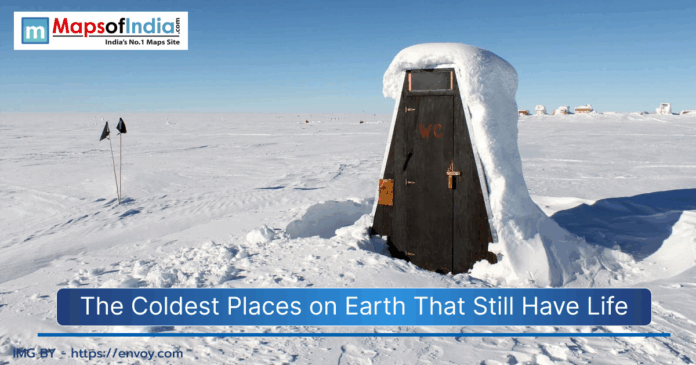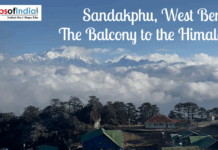For life to exist on Earth, there need to be specific environmental conditions to meet, and extreme cold is not one of them, but in some parts of the world, Life endures in extreme cold. These places push human limits. Inhabited places on earth, like Oymyakon, have -71°C. In Antarctica, there are many Research stations that host scientists year-round. Vostok has a low temperature of -89°C with temporary residents. Permanent settlements in these areas still thrive despite facing harsh winters. Animals in these areas also adapt to this environment. Penguins in Antarctica survive -60°C.
Oymyakon, Russia: Siberia’s Freezing Village
Oymyakon is Russia’s coldest place, which is still inhabited. This place is situated in the Sakha Republic and has 500 residents. At the time of winter, the temperatures drop to as low as -71.2°C. At the time of January, the average temperature of this area is -50°C. A recent Islands article calls this place the Pole of Cold. During the summer, the temperature reaches 30°C. People in this area live in insulated wooden homes. Indoor plumbing freezes. The diet of people living in this area includes frozen fish and reindeer meat. The fishing in this area is done through ice holes. Children are required to attend school until the temperature reaches -52°C. After that, classes are cancelled. Yakut horses graze at -70°C. To survive here, fur coats are essential. Oymyakon’s isolation is 2 days from Yakutsk. Life is mostly focused on survival. Inhabitants adapt with layered clothing and hot tea. This village shows human endurance.
Yakutsk, Russia: World’s Coldest City
Yakutsk is one of the coldest major cities in the world. This city is the capital of the Sakha Republic, which has a population of 355000 people. The winter in this place is average, below -40°C. The record low of this city is -64.4°C. A Treehugger article says it’s built on permafrost. Buildings of the city stand on stilts to avoid melting. To survive in this city, residents wear fur-lined coats. Market stalls sell frozen fish that seem like bricks. The diet of the city includes stroganina and raw frozen fish. Schools close when the temperature reaches below -45°C. Most of the time of year, children play indoors. The residents of this city are mainly diamond mining employees. According to the Culture Trip report, 25% of the world’s diamonds are from here. Fog from breath freezes lashes. People use heated garages. Yakutsk has underground malls. Life thrives despite the cold.
Vostok Station, Antarctica: Research in Extreme Cold
Vostok Station is Antarctica’s coldest spot. Russian outpost records -89.2°C in 1983. This station has an average temperature of -32°C in summer. In these harsh conditions, 30 scientists live at this station year-round. At the station, they study ice cores for climate data. According to the NASA report, this place has a 4 km deep drilling. Life is isolated in this station. Supplies arrive by plane yearly. Heated module houses are used for residents. Diet at the station is mostly canned food and frozen meat. No fresh produce grows in the soil. Researchers see 6 months of darkness. To select scientists working at this place, psychological tests are conducted. Vostok’s lake beneath the ice holds key information about ancient life. Subglacial water samples reveal microbes. Adaptations include thermal suits. This station shows human resilience in an uninhabitable cold.
Dome Fuji Antarctica: Japanese Outpost in Freezing Isolation
Dome Fuji is a Japanese outpost in the Antarctic extreme. This Japanese station recorded the lowest temperature of -93.2°C in 2010. A NASA report confirms that this is Earth’s coldest. 10 to 15 researchers stay at this place in the summer. During winter, evacuations occur due to the extreme cold. At this place, they drill ice cores 3 km deep. According to the recent BBC article, these cores reveal 720,000 years of climate history. Life at this place goes on in confined modules. Heated tunnels are built to connect buildings. Solar panels for power. The diet is mostly freeze-dried food. Fresh veggies are hard to find here. Isolation lasts for months. Radio contact is vital. Dome Fuji’s microbes in ice show life in extreme conditions. A study conducted by Nature found bacteria surviving -80°C. Adaptations at this place include insulated suits. This station pushes scientific boundaries.
Utqiagvik, Alaska: Northernmost U.S. Settlement
Utqiagvik is the coldest town in Alaska. Formerly Barrow, this place has 4000 residents. The average temperature of this area in winter is -20°C. The record low temperature at this place is -56.7°C. A Treehugger article ranks this place among the coldest inhabited. The Inupiat Eskimos tribe forms 60% of the population. They hunt whales and seals for a living. The traditional diet of this palace includes muktuk. Homes are built on pilings above permafrost. According to the recent article in the Guardian $1000 is needed each month for heating costs. Polar night lasts 65 days. Schools teach the Inupiaq language. Tourism at this place is growing due to the Northern Lights. Adaptations include snowmobiles and fur clothing. Life revolves around subsistence hunting. This Iñupiat hub shows Arctic resilience.
Ulaanbaatar Mongolia: Steppes’ Freezing Capital
Ulaanbaatar is known as Asia’s coldest capital. This city in Mongolia has 1.6 million people living there. The average temperature during winter is -25°C. The record low temperature of this place is -42°C. This place has a continental climate. Ger districts surround the city. To generate heat, residents use coal stoves. A Treehugger article says air pollution increases in winter. The diet of this city includes mutton and dairy. A recent BBC report notes buzz dumplings for warmth. Schools in the city close when the temperature reaches below -32°C. A Guardian article says children bundle in layers. Mining is the main source of the economy. According to the recent report by Culture Trip, 30% of GDP comes from minerals. Adaptations in this city include insulated boots. Ulaanbaatar blends nomadic traditions with urban life.
Norilsk, Russia: Industrial Cold Hub
Norilsk is an industrial cold hub known as Russia’s northernmost city. This city has 174000 residents. The average temperature during the winter is -30°C. The record low temperature of this place is -53°C. A Treehugger article ranks this place among the coldest. Most people of the city are employed in Nickel mining. Norilsk is the world’s largest producer of Nickel. According to the BBC report, it contributes 2% of global GDP. Pollution from smelters is severe. The diet of this place includes reindeer meat and fish. Schools run until the temperature reaches -40°C. Buses are heated to transport kids. Polar night lasts 45 days. Norilsk shows industrial life in the cold.




